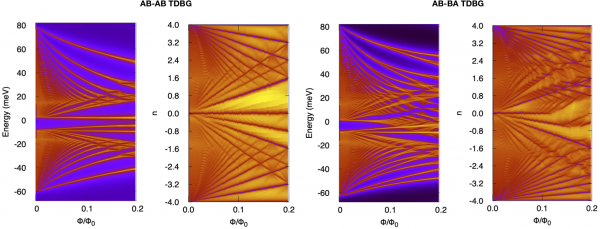Landau levels serve as probe for band topology in graphene Moiré superlattices
by Carey Sargent, NCCR MARVEL, EPFL
The exceptional properties of twisted bi-layer graphene (TBG) and related moiré superlattices have attracted a lot of attention from both experimental and theoretical physicists in recent years. Though the physical mechanisms behind features such as correlated insulating phases and superconductivity are still subject to debate, the small bandwidth and the non-trivial topology of the relevant bands point to new, interesting physics.
Probing the topological properties of this curious material made of two atom-thin sheets of carbon with a small twist of 1.1 degrees is difficult experimentally because they are “hidden” in nature. The properties of the two valleys inherited from monolayer graphene counterparts generally cancel each other out and so cannot readily be detected. In the paper Landau Levels as a Probe for Band Topology in Graphene Moiré Superlattices the researchers propose using Landau levels—the cyclotron orbits with discrete energy values that can be occupied by charged particles in magnetic fields—as the basis for probing the topological character of such electronic bands.

Landau levels and Wannier diagrams for the flatband manifold in the AB-AB(left) and AB-BA(right) configurations of TDBG at twist angleθ of 1.89 degrees.
Yazyev and colleagues QuanSheng Wu, Yifei Guan, scientist and PhD student at the Chair of Computational Condensed Matter Physics at EPFL, respectively, and Jianpeng Liu, professor at Shanghai Tech University, demonstrate the idea using the example of twisted double bilayer graphene (TDBG), a system constructed by twisting two AB-stacked bilayer graphene (BLG) sheets. Recent research has indicated that this four-layer moiré heterostructure features several novel properties such as the gap opening at large twist angles and two types of stacking configurations that have distinct topological properties. The material is also interesting because the band structure and topological properties of TDBG can be controlled by applying external electrical fields, possibly leading to a quantum anomalous Hall effect.
The researchers investigated the use of Landau levels as a probe for band topology by looking at two different configurations of the material, AB-AB and AB-BA, which are linked through a rotation of the BLG by 180 degrees with respect to each other. While both belong to the D3 symmetry group, they differ in having C2x and C2y symmetries, respectively. Though the two were found to have very similar band structures, the differences in symmetry result in different band topologies.
The C2x symmetry requires the Chern number—the number determining the quantized Hall conductivity of an insulator—for each valley to be vanishing, while C2y doesn't. Furthermore, the time-reversal symmetry requires the Chern numbers of the two valleys to be opposite. The AB-AB configuration of TDBG has trivial valley Chern numbers then, while the AB-BA configuration is topologically nontrivial. The Chern number is in fact the integral of the Berry curvature that affects the Landau level (LL) spectrum when a magnetic field is applied. Using Hofstadter's butterfly—a description of the spectral properties of non-interacting two-dimensional electrons in a magnetic field in a lattice—the researchers were then able to show that the LL spectra of the AB-AB and AB-BA configurations of TDBG are dramatically different.
This makes it possible to discriminate between them despite the fact that their band structures are virtually indistinguishable. “The proposed approach can be easily extended to other moiré systems such as twisted graphene multilayers and h-BN/graphene heterostructures,” Yazyev said.
References:
Q. Wu, J. Liu, Y. Guan, and O. Yazyev, Landau Levels as a Probe for Band Topology in Graphene Moiré Superlattices, Physical Review Letters 126, 056401 (2021). [Open access URL]
Low-volume newsletters, targeted to the scientific and industrial communities.
Subscribe to our newsletter